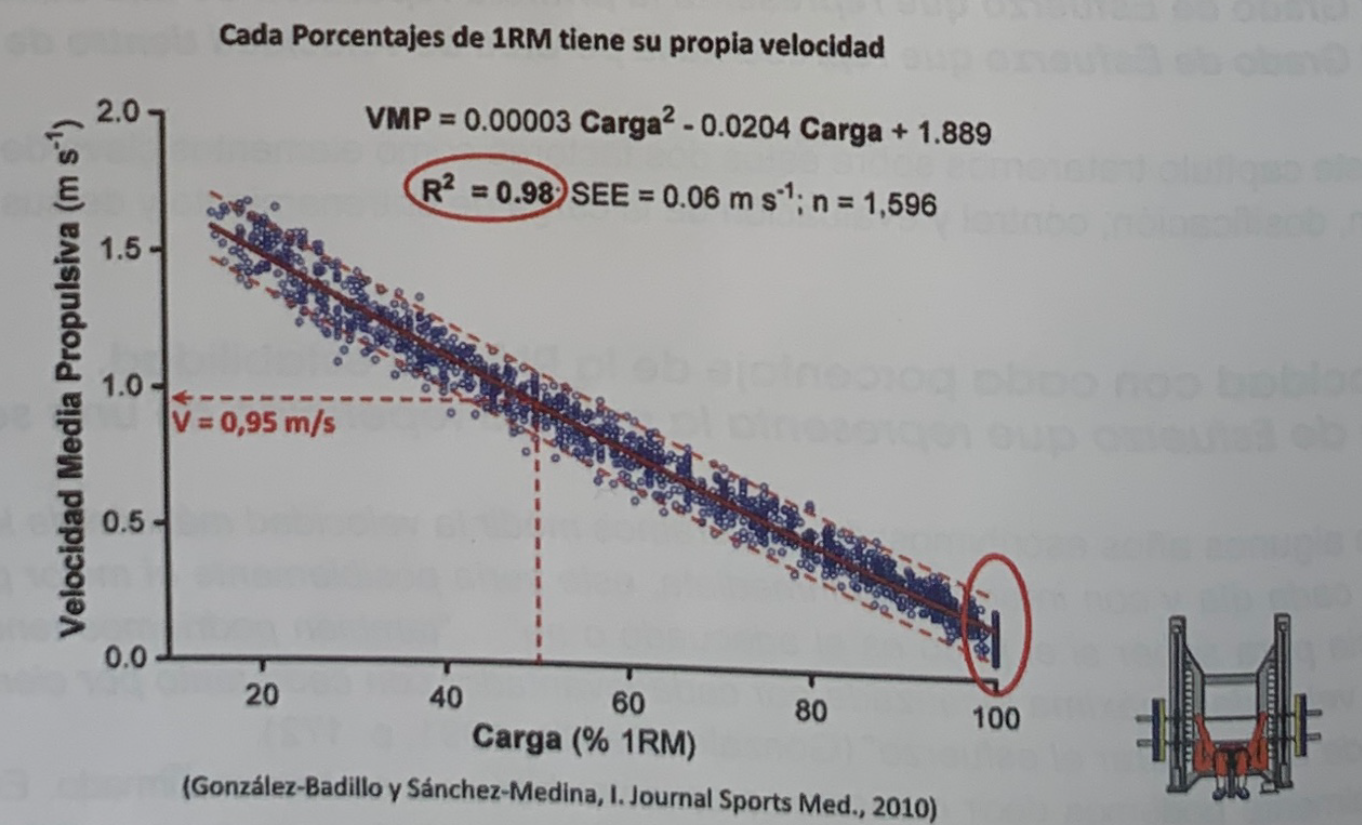Effect of execution speed on training
Throughout these articles, a series of contributions that can provide the effect of execution speed and its control have been reviewed. But for this it has been necessary for the loads to be moved at the maximum speed possible both in the execution of the exercise with which it was intended to know the relationship between percentages and speed and when estimating fatigue or the percentage of repetitions performed in the series or the calculation of the Effort Index.
In this series of articles we deal with some of the most important concepts of strength training, collecting notes from the recently published book Strength, Speed and Physical and Sports Performance written by renowned researchers Juan José González Badillo and Juan Ribas Serna.
Summary
- The results of these two studies showed a clear tendency to improve more when, after controlling for all possible known variables, the bar was moved at the maximum speed possible than when it was done at half that speed.
- The way to equalize or make very similar the degree of effort for different people before the same relative load is to equalize the loss of speed in the series.
- by measuring the speed of the first repetition it is possible to guarantee that the subject has trained with the programmed relative intensities
- The group that trained to achieve a loss of speed of only 20% of the initial speed showed a tendency to offer better results
- The group that trained until achieving a reduction of only 20% of the initial speed showed a tendency to offer better results
It could be argued that an important part of the contributions that have been discussed would not be applicable because to train with external loads it is not necessary to move them as fast as possible or it is even better to move them slowly voluntarily. When the variables that could influence the results are adequately controlled, the greatest training effect is achieved if the loads are moved at the highest possible speed (González-Badillo et al., 2014; Pareja-Blanco et al., 2014).
To address the problem of what effect speed of execution has on physical performance, the two studies cited in the previous paragraph and in previous chapters were carried out, one with the bench press exercise and the other with the squat. In both cases, they trained with loads between 60 and 80% of the actual RM. The percentages can be considered real because in each training session it was verified, through the speed of execution, what absolute load (mass) represented for each subject the percentage of the programmed RM.
Two groups were randomly formed: one (n=9 in the bench press and n=10 in the squat) that performed each repetition at the maximum speed possible (GV100), and another (n=11 in both exercises) that performed each repetition at 50% of the maximum speed possible (GV50).
In each exercise the two groups trained with the same actual relative intensities and the same sets and repetitions per set. That is, all the training variables were identical except for the speed of execution.
As can be deduced from the information provided about the programmed training and, especially, the training performed, the independent variable in this study was the voluntary speed of execution, and all the other variables with a possible influence on the dependent variable were controlled. It is true that the GV100 lost speed in the series and the GV50 did not lose speed, since all the repetitions of each series were done at the same average speed.

In addition, not only was the real percentage at which each group trained and the speed at which they performed the first repetition in each series in both cases controlled and known, but also the specific average speed at which each group trained. Since the execution speed for the same repetitions was different, there has been a difference between the groups derived and unavoidable from this circumstance, which is the time under tension. But, thanks to the measurement of the speed in each of the repetitions performed, we can have a precise assessment of the magnitude of these differences and assess the results despite this factor.
Since the speed was measured before all the loads in the initial test and in the final test, it was possible to incorporate in the analysis of the results the comparison of the mean of the VMP of the common pre-post training loads. This type of analysis is an important contribution based on the speed of execution and an important advance in the assessment of the training effect for two reasons:
i) because the improvement in physical performance, and in many cases in specific performance, in any sport is measured by changes in speed under the same load (mass). Only weightlifting is excepted, which consists of moving more and more load at the same speed, and
ii) because when using the same absolute load to evaluate the effects, the precision in the pre-post training reference loads for the comparison of the effects is the maximum possible. Furthermore, this comparison allows such a comprehensive assessment of training effects that one could (should) dispense with the comparison of MR changes.
In addition to the previously mentioned changes, it was possible to measure the effects of the training before light loads, that is, the loads that in the initial test moved at speeds ≥1 and ≥0.8 m s-1, for the squat and bench press, respectively, as well as for heavy loads, which in the initial test moved at ˂1 and ˂0.8 m s-1, for the squat and bench press, respectively. As can be easily deduced, these analyzes make it possible to check not only if the RM improves to a greater or lesser extent, and even if the average velocity improves with the set of loads measured, but also if the changes have been proportionally different in some areas or others of the force-velocity curve depending on the load used or, in this case, the type of execution performed.
The results of these two studies showed a clear tendency to improve more when, after controlling for all possible known variables, the bar was moved at the maximum speed possible than when it was done at half that speed. This result occurred despite the fact that the time under tension was higher in GV50, from which it can be deduced that, probably, a longer time under tension is not determinant for the improvement of strength. This variable cannot be considered as a strange variable, since it is a consequence of the different execution speed, and naturally has a directly proportional relationship with it.
A clear tendency to improve more when moving the bar at maximum speed shows the effect of execution speed.
It is hard to find a more precise procedure for measuring time under tension in strength training by accurately measuring the execution time in the concentric phase of the movement for each of the repetitions performed during the entire training cycle: this is another great application of speed control.
In fact, the incorporation of these two studies, carried out with a high control of possible extraneous variables, is not done at this time to show the effect of training on performance, but because it was necessary to justify the multiple applications of execution speed on the dosage, control and evaluation of training. Therefore, from what is stated in the description of the design we can deduce that an adequate use of speed allows:
- Dose / program the load (relative intensity) of the training through the speed and control that each training session is carried out at the programmed intensity through the measurement of the speed of the first repetition of the series.
- Know the real average speed with which you have trained throughout the cycle individually and as a group.
- Know the real time under tension of the entire training.
- Evaluate the effects of training in different zones of the force-velocity curve.
- Estimate and compare the changes on the RMs.
- Compare the changes in the mean of the VMP of the common loads pre-post training. This comparison could (should) allow to eliminate the comparison of the RMs.
Examples through studies on the effect of the loss of execution speed in the series
In the two previous articles, three studies have already been exposed in which the relationship between the loss of speed in the series y fatigue, metabolic stress, the percentage of repetitions performed and the creation of a Effort Index. In the first of them, the immediate effect of a greater loss of speed in the series with different relative loads on fatigue and metabolic stress has been analyzed, in order to estimate the degree of effort or load that a certain loss of speed entails.
In the second, it has been shown how the way to equalize or make very similar the degree of effort for different people before the same relative load consists in equalizing the loss of speed in the series, and not the number of repetitions that are performed in the series before the same relative intensity. And in the third, the necessary data have been provided to validate a new index, which we have called the Effort Index (IE), as a product of the speed of the first repetition in the series and the loss of speed within the series itself. .
The way to equalize the degree of effort for different people before the same relative load is to equalize the loss of speed in the series.
Once the information derived from these studies is known, what is proposed to contribute now is information on the applications of the speed of execution when it comes to trying to verify the effect that certain losses of speed have before different relative intensities, and, in some cases, also include information on the IE associated with these training sessions.

These are experimental studies in which the effects of different speed losses in the series are compared to different relative intensities. The implementation of these studies derives from the attempt to answer a series of questions. In the studies previously analyzed, it has been seen that, for the same absolute or relative load, the degree of fatigue is greater the greater the number of repetitions performed in the series, or rather, the greater the loss of speed in the series. The questions now would be the following:
- What is the degree of fatigue necessary to obtain the best results? Based on what has been exposed when talking about the drawbacks of load dosage through an XRM, it seems that reaching muscle failure or trying to reach maximum volume in the series is not the best.
- But what load / degree of fatigue / volume below the maximum achievable are the most suitable?
- If the load of each training session is defined by the fatigue it causes, how do we quantify fatigue and check its effect? In this sense, it is probable, as we have seen, that one of the most precise and easy to apply procedures is the loss of speed in the series, which, moreover, is in accordance with what is stated in the classic texts where fatigue is defined as the loss of strength or loss of speed or loss of power before a determined load.
- But what degree of speed loss is most effective? Naturally, it is not possible to verify in a single study all the possible combinations of speed stalls and relative intensities and subjects on which they are applied. But it is necessary to continue advancing in this sense if the aim is to improve the training methodology. To carry out this task it is essential to make adequate use of speed control, both to define the relative intensity and to quantify fatigue.
The study being analyzed (Pareja-Blanco et al., 2017) aimed to verify the effect of two percentages of speed loss (different degrees of fatigue) training with the same relative intensity. The only training exercise was the squat. He trained for eight weeks, two sessions per week. The relative intensities oscillated between 70 and 85% of the real MR, and were applied progressively. Three series were performed with the maximum intensity of the day.
The independent variable was the loss of speed in the set, which means that a certain number of repetitions per set was not programmed. Each subject performed repetitions in the set at the maximum speed possible until the programmed speed was lost. This means that not all the subjects of the same group performed the same repetitions neither in the series nor, naturally, in the training session. Common training variables within the group were velocity loss in the set and relative intensity.
For one group (n = 12) a loss of speed in each series of 20% was programmed with respect to the speed of the first repetition with the maximum intensity of the session (G20). For the other group (n = 10) an approximate mean loss of 40% (G40) was programmed.

The contributions of having been able to measure the speed in each of the repetitions performed by each subject throughout the training are multiple and relevant. Some of them are highlighted below.
- Only by measuring the speed of the first repetition is it possible to guarantee that the subject has trained with the programmed relative intensities, also allowing another important objective, such as adjusting the load (relative intensity) to the actual physical situation of the subject in each training session. This in turn guarantees control of a determining variable of load and performance, such as relative intensity. If not controlled, this variable would become a powerful foreign variable, which would undoubtedly influence performance, for which reason it was necessary to control it, which in this case was done by equalizing the speed of the first repetition of the first series with the maximum load of the day in all subjects. We do not know of (probably does not exist) any more precise procedure to control / equalize the relative intensity used by different subjects than the speed of execution with the first repetition of the series.
Only by measuring the speed of the first repetition is it possible to guarantee that the subject has trained with the programmed relative intensities, also allowing another important objective, such as adjusting the load (relative intensity) to the actual physical situation of the subject in each training session.
In the study that concerns us, the independent variable has been the loss of speed in the series. But this loss would not have made sense if the relative intensity of each session had not been controlled, because they would have been speed losses at different relative intensities. This control can only be done by measuring the speed of the first repetition, which should have been the same for the two groups. Indeed, the mean speed of the first repetition of all the sessions was practically the same for G20 (0.76±0.01 m s-1; CV = 1.3%) than for G40 (0.75±0 02 m·s-1: CV = 2.6%), and with a similar and very small variability.
These data, in turn, allow us to know the real average relative intensity of the maximum intensities applied, simply expressing the speed as a percentage of the RM. In this case, a speed of 0.75-76 m s-1 corresponds to 75% of the RM in the squat exercise (Sánchez-Medina et al., 2017)
- As in the previous studies, measuring speed makes it possible to check the effects of training at different speeds (light, medium and high loads), as well as at the average speed of all common loads displaced pre-post training, not only at MRI, as usual.
- It is possible to know with high precision the average speed lost in the series by the different groups and by each participant. In the study analyzed, the mean loss of exact speed was 20.4 ± 1.5% of the speed of the first repetition of each series for G20 and 41.9 ± 1.9% for G40. The low value of the standard deviation (CV of 7.3 and 4.5% for G20 and G40, respectively) indicates that these losses were very similar for all subjects in the same group.

Talking about the average speed lost during the entire training cycle is like talking about the degree of fatigue generated for each group and each subject individually. If we take into account that what is always programmed is a CE / degree of effort, which represents a degree of fatigue, which validates the CE itself, knowledge of this data is the most relevant of what can be expected in relation to the load applied or generated by the training already carried out.
- In this study, since the speed has been measured in all the repetitions, it is possible to know the Mean Propulsive Velocity (VMP) of the total repetitions performed during training with the maximum loads in each session, which in this case was higher in G20 (0.69±0.02 m s-1) significantly than in the G40 (0.58±0.03 m·s-1).
Since in this study the G20 has shown a tendency to offer better results, this greater speed before the same relative load confirms the results of the studies in which the effect of execution speed was compared with the same relative intensity, in which the groups that carried out the training at a higher speed tended to obtain better results. It also allows us to reflect on the fact that with the same relative load, a difference of only 11 hundredths of more-1 in the average speed (0.69-0.58 m s-1) can generate effects with a clear trend in favor of the group with the highest average speed (G20) and in some cases obtaining significant differences in favor.
The group that trained until achieving a reduction of only 20% of the initial speed showed a tendency to offer better results
To know the total number of repetitions performed during training, it is not necessary to measure the speed, it would only be necessary to count repetitions. However, if the loss of speed in the series has been very similar for each of the subjects in the same group (20.4±1.5% for G20 and 41.9±1.9% for G40), a high variability in the number of repetitions performed for the same loss of speed would allow us to confirm that it would not be correct to program the same number of repetitions with the same relative intensity.
Indeed, in the present study, the number of repetitions performed with the maximum intensities of each session was 185.9±22.2 repetitions for G20, which means a CV of 12%, and for G40 310.5±42, with a CV of 13.5%. This means that, in G20, taking 1 standard deviation above and below the mean number of repetitions performed, in the extreme values of 68% of the subjects there was a difference of 44 repetitions (±1 dSt), and of 88 repetitions if we go to the extreme values of 95% of the subjects (±1.96 dSt). In the G40 these repetition values were 84 and 168 for one and two standard deviations, respectively.
This means that the degree of fatigue in the subjects of the same group was very similar, as indicated by the average value of speed loss in the series and the low standard deviation, but the range of repetitions performed is wide, confirming the error that can be made when the same number of repetitions is proposed to all subjects at the same relative intensity. In the cases of the G40, the calculations indicate that an approximate difference of 10.5 repetitions of half a session was produced (168 repetitions/16 sessions). This information can only be obtained if the speed of execution is measured.
- Whatever the procedure for determining the training load, the two most determining factors, and unique to the same exercise, are intensity and volume. In the type of training that we usually call “strength training” the volume must be represented by the repetitions performed. But it is clear that two workouts with the same volume can represent two very different loads depending on the intensity with which they have been achieved. Therefore, a volume value without an intensity indicator does not make sense because it does not provide sufficient information about the degree of charge. If we add the average intensity value to the volume value, the information is higher. But an average value (an arithmetic mean) does not detect the variability of the data or the extreme values, so two equal volumes with the same average intensity can represent two very different loads depending on how said volumes have been distributed among the intensity values. For example, a 20 rep 70% 1RM workout has the same volume and average intensity as 4 reps at 50%, 4 at 60, 4 at 70, 4 at 80 and 4 at 90%, however these are clearly two very different workouts. Therefore, to adequately define the load before the same exercise, it is necessary to know the volume and the volume distribution between the intensities.
- In order to distribute the volume among the intensities used, intensity zones are usually created, from the smallest values to the highest, with usual intensity limits per zone of 5%. For this, different percentages of the RM are taken, for example, from 40-45%, >45-50; >50-55… and so on. But as we have indicated, using the RM as a reference to dose the training is very likely to introduce a lot of error, in the sense that the real percentages represented by the absolute loads used could be very different from those programmed. Indeed, The solution to this problem lies in the use of speed zones instead of percentage zones, because the speed at which the charges have moved expresses very precisely what real relative intensity the subject has used.
This type of distribution makes it possible to analyze discrepancies in the training effect when the same repetitions have been programmed for all subjects at the same relative intensity.
Less fatigued subjects (those who can do more repetitions per series) will present a greater number of repetitions at a higher speed, and, therefore, a higher average speed.
Therefore, the distribution of repetitions by speed zones allows:
- Differentiate the degree of effort made by each subject.
- Analyze the load-effect relationship or the execution-effect relationship of the training.
- It allows all repetitions to be located in their true zone, which is not possible if the percentage of the RM is taken as a reference. For example, if a subject performs 6 repetitions with 75% of the RM, all the repetitions would go to the zone in which the 75% is found, when in reality, not all the repetitions have been carried out at the same speed, that is, not all the repetitions have meant the same effort, so the information on the degree of effort made, which is the key to quantifying the load and the effect of the training, will be very imprecise. If, on the contrary, the speed with which those same repetitions were made had been measured, each of them would have been located in the corresponding speed zone, which would not be the same for all of them, thus indicating the effort that the series has meant in a much more precise way.
The distribution of repetitions by speed zones can be a powerful tool to explain the training load and its effect.
Figure 1 shows an example of the consequences of quantifying the training load taking as a reference the repetitions to be performed in the series versus programming the loss of speed in the series in two subjects with different characteristics.
If the training is programmed through the number of repetitions (text with a yellow background), everything that appears in the rest of the figure also results with a yellow background:
- The programmed number of repetitions is the same for both subjects: 7.
- The relative intensity is the same, since both start the training at 1 m s-1 in the first repetition.
- The two perform 7 repetitions, but subject 1 has reached a speed of 0.7 m s-1 in his last repetition, while subject 2 has reached 0.82 m s-1, which means that :
- Subject 1 has lost 30% of the speed of the first repetition, his average execution speed has been 0.85 m·s-1 and he has performed 5 repetitions at ≥0.8 m·s-1.
- While subject 2 only lost 18%, he reached an average speed of 0.91 m·s-1 and performed 7 repetitions at ≥0.8 m·s-1.
All this means that both subjects, although they have trained with the same relative intensity and with the same number of repetitions, have made a quite different effort, that is, they have carried out two different training sessions, determined by a greater degree of fatigue and by a lower average speed of subject 1 compared to 2.
However, if the same loss of speed is programmed in the series with the same relative intensity, everything that appears with a green background in the figure occurs:
- The two subjects lose the same speed in the series and perform the same average speed in the total number of repetitions, even though subject 2 has performed 5 more repetitions.
Differences between programming the same number of repetitions against the same loss of speed.
Figure 1. Differences in the training load between programming, at the same relative intensity, the repetitions to be performed in the series or programming the loss of speed (see text for further clarification).
In this case, the two subjects have reached the same degree of fatigue and have trained at the same average speed. This is what defines the training load, taking the number of repetitions to the background and being something almost anecdotal, as long as these requirements are met:
- Same speed on the first repetition.
- Maximum possible speed of execution in all repetitions.
- Same loss of speed in the series.
If this is the case, the training loads, the efforts, the fatigue, the average speed of execution and the IE will be the same for the two subjects, although in the count of the repetitions the number performed is different in each case.
Definitely, this type of information is the most relevant and precise to be able to carry out an analysis of the true load that has caused a certain effect, because it reflects very clearly the degree of effort made.
Continuing with the study data, a real example of the information that the distribution of repetitions by speed zones can provide is given. Table 1 shows this distribution of repetitions between the different speed zones.
Tabla 17.1. Distribution of the repetitions performed, including the warm-up, between different speed zones (relative intensity).
| squat
(Velocity zones: m/s) |
G40 | G20 |
| ˂0,3 | 3,2 ± 0,4 | 0,2 ± 0,4 |
| 0,3-0,4 | 30,3 ± 8,5 | 0,6 ± 1,2 |
| ˃0,4-0,5 | 56,1 ± 13,1 | 7,0 ± 3,3 |
| ˃0,5-0,6 | 81,4 ± 19,7 | 30,3 ± 5,6 |
| ˃0,6-0,7 | 97,6 ± 6,3 | 66,6 ± 7,3 |
| ˃0,7-0,8 | 88,4 ± 14,8 | 83,7 ± 12,7 |
| ˃0,8-0,9 | 70,6 ± 9,6 | 60, ± 8,7 |
| ˃0,9-1,0 | 69,9 ± 10,7 | 56,6 ± 5,0 |
| ˃1,0-1,1 | 67,3 ± 17,0 | 48,3 ± 9,0 |
| ˃1,1-1,2 | 27,1 ± 11,7 | 28,6 ± 14,5 |
| total repetitions | 594,3 ± 42,3 | 383,9 ± 22,2
(64.5% of the G40) |
The G40 performs more repetitions than the G20 because it loses more speed in the series. Este mayor número de repeticiones se produce en todas las zonas de velocidad excepto en la zona >1,1 m·-s-1, en la que están prácticamente igualados. But the differences are manifested mainly in the areas ≤0.7 m·-s-1, which clearly lowers the average speed of execution during the cycle from 0.69 in G20 to 0.58 m·-s-1 in the G40 with the maximum loads of each session.
It is reasonable to accept that this lower average speed, although apparently small, of only 0.11 m·-s-1, is responsible for the lower performance obtained by the G40, especially under light loads (2), because it cannot be deduced that this lower performance is due to the fact that they did fewer repetitions with high speeds, because with the speeds from >0.7 to 1 m·-s-1, the G40 also performs more repetitions than the G20. Therefore, the number of extra repetitions that the G40 has performed for having continued doing repetitions after losing 20% of the speed, does not seem to have contributed anything positive.
It is also worth noting the fact that small differences in average speed, such as 0.11 m·-s-1, can give rise to quite different effects, in this case in favor of the higher average speed. Although, if this is so, we could give another interpretation to this “small” difference in speed, considering that these differences “are not so small”, but large enough to cause clear changes in performance.
In this sense we add another great advantage of speed control, which is explained as follows. If the distribution of the repetitions by zones of percentages of the RM had been made (we must take into account that this was a great advance in the control of the training load at the time, and that it comes from the technicians and researchers of the former Soviet Union, especially from Russia), and we wanted to know the average intensity of the entire training cycle, we would be forced to multiply the average value of each intensity zone by the number of repetitions performed in each zone, later calculating the weighted average derived from all these products.
For example, if the zone were ˃65-70, we would multiply 67.5 (the mean of 65 and 70) by the number of repetitions performed in that zone, and so on for all other zones. In this way we would have an approximate average training intensity. However, having measured the execution speed of each repetition, we have the exact average execution speed of all the repetitions of the cycle, without the need to make subsequent approximate calculations in a similar way as we have described for the percentage zones. This calculation could also be done with the speed zones, but, in addition to being unnecessary, the results would be much less precise.
In relation to the above, it should also be taken into account that the average speed of the entire cycle could be expressed as a percentage of the RM, simply by checking what percentage of the RM corresponds to the average speed performed. In the example of the study that we have been commenting on, the average speed with the maximum loads of each session was 0.69 m·-s-1 for the G20, which is equivalent to having trained with a relative and average intensity of 80% of the RM (80% corresponds to a speed of 0.68 m·-s-1), and the G40, whose average velocity with these charges was 0.58 m·-s-1, with 85% (85% velocity is 0.59 m·-s-1).

That is, the difference in the average percentage of the RM was slightly more than 5%. Here another important advantage of speed control is manifested, since having made the calculations and the distribution of the repetitions through the percentages, apart from the imprecision derived from the calculations, already mentioned, the big problem is that a significant part of the repetitions have not been done with the programmed percentages, and, therefore, the repetitions are not in the real zones that should correspond to them, given the inevitable changes in the RMs values. All of this is overcome by using speed to control the training load.
If we add a complementary study to the study that we have been discussing (Rodríguez-Rosell, Doctoral Thesis) in which, training with the same relative intensities, the speed losses were 10% (G10) and 30% (G30) of the MRI speed, we can obtain even more information and confirm what we have already obtained.
Table 2 shows the distribution of repetitions by speed zones of this new study together with that of the previous study. The results of the groups that lost 20 and 40% of the RM have already been compared. Now it is interesting to compare the group of 40 with the one of 10% loss of speed.
The G10 performed better than the G40, especially in actions performed at high absolute speed, that is, with light loads, and even in an exercise performed at high speed, not trained, such as the CMJ (counter movement jump). El G10 no solo realizó muchas menos repeticiones en el ciclo de entrenamiento que el G40 (46,7% de las que realizó el G40), sino que, a pesar de haber mejorado claramente mas con cargas ligeras, realizó menos repeticiones con las cargas de alta velocidad (>0,8 m·-s-1).
These results confirm the importance that the loss of speed in the series can have in the results and in the quantification of the training load. Because, as previously noted, it seems clear that, again, the G40 doesn’t improve less under high-speed loads because it didn’t train with it, but rather because it continued to lose speed beyond what the data indicates it should lose.
Repetitions performed by speed zones according to loss of speed in the series in the squat exercise

Tabla 2. Distribution of the repetitions performed, including the warm-up, between different speed zones of four training groups with the same relative maximum intensities and different speed losses in the series.
With the information contained in Table 2, numerous analyzes can be carried out, which will have the great advantage that they will be based on very precise data on the real load that each group or each subject has carried out, because the two variables that determine the load are being accurately reported: intensity and volume.
The relative intensity of each session is programmed through the speed of the first repetition, but Table 2 shows the frequency with which you train with each relative intensity, that is, the true training and the true intensity with which you train. has trained. In turn, this frequency and the total number of repetitions performed (volume) are conditioned by the loss of speed, which is also programmed.
The volumes by groups are comparable, because it is assumed that in each group there must be the same or a similar number of subjects who can do both a high and a low number of repetitions, as well as the average number of repetitions that can be done before each loss of speed. But this cannot be applied to compare individual subjects, because one of them could do many more repetitions than the other with the same loss of speed.
Therefore, volume as an indicator of performance between individual subjects should not be an important reference data for analyzing training load and its effects. Given the same loss of speed in the series and the same speed of the first repetition, the loads will be equivalent, even if the volumes are different. Which does not mean that if the charges are equivalent, the effects are also equivalent.
volume as an indicator of performance between individual subjects should not be an important reference data for analyzing training load and its effects
But precisely from here arises a new way of analysis provided by speed control, in such a way that this control can modify what is considered almost a principle “the same training load can produce a very different effect in different subjects”. But, really, when you say this, are you talking about the same load? We would bet that this has never happened, because always the proposed load, especially the repetitions in the series “have had to be the same for everyone”, because “the repetitions that offer the best results are xxx”.
It is evident that few subjects in the same group train with the same load if they all do the same repetitions in the series. Therefore, it would remain to be verified to what extent the same real load has different effects for different subjects and to what extent these differences would occur. At this time, we have data to begin to answer these questions, but this is not the time to deal with them now.
As can be deduced from everything that we have been exposing, speed control and proper handling of the information it provides can be an important and powerful tool for learning what it means to train.
Figure 2 shows the results of the two studies that have been discussed. In it you can see the clear tendency to improve more under light loads (7 and 66% vs. 0.8%) and in the CMJ (9.1% vs. 3.7%) when 10 and 20% of speed is lost vs. 40%, and they improve practically the same, or even somewhat more, in percentage terms, with high loads or when moving at low speeds (lower area of the force-velocity curve), an area for which, according to the literature, it is necessary to train until muscular failure. In the lower left part, the IE reached by each group appear before the maximum training loads. The table on the right shows the sums of the improvement percentages of each group in the set of dependent variables.

Figure 2. Effect of four requests for speed in the series with respect to the first repetition before the same maximum relative intensities: 70 to 85%. Vel–med(%): average speed with all absolute loads common to the initial test; Vel–≥ 1 m·s-1: speed with loads equal to or greater than 1 m·s-1 of the initial test; Vel–˂ 1 m·s-1: speed with loads less than 1 m·s-1 of the initial test.
Figure 3 shows the results of these same training sessions in the 20 m race. It is confirmed that not only in the tests with loads or the vertical jump the effects of a low loss of speed are more favourable, but that this same tendency is also manifested in actions with a higher absolute speed of execution, such as the 20 m race. To the right of the figure the sum of improvements of the different groups is indicated. With 10 and 20% of speed loss there is an improvement in times, while it tends to increase when 30 and 40% are lost.
This exercise was not trained during the time the study lasted. We are, therefore, before a true transfer test (positive and negative, depending on the case) of the training of the complete squat on the 20 m race. It seems reasonable to accept that the determining factor for one type or another of transference to occur is not the relative intensity, but rather the degree of fatigue generated in the series.
The determining factor for one type or another of transference to occur is not the relative intensity, but the degree of fatigue generated in the series.

Figure 3. Effect of four speed losses in the series with respect to the first repetition before the same maximum relative intensities: 70 to 85% on the times in the 20 m race.
What was commented at the end of the previous paragraph puts us before one of the important and permanent objectives of the training task, which is to know the effect that the improvement of a training exercise can have on a different exercise, whether this is also trained or not. It is, therefore, before the much brought and carried transference, but well understood. The answer to this question, as we have already pointed out, can be given by the fact of measuring speed in each training session, thus giving us a new important application.
If the training effect is assessed every day without doing any special test, but simply by measuring the speed of execution with absolute loads, we will have the evolution of the training effect permanently updated and, therefore, the changes that it produces in the measured variable throughout the cycle. But if, in addition, we measure some other type of performance in some exercise every week, trained or not, we will be able to verify to what extent the changes in performance in both exercises are or are not related and in what sense.
Well, in a study in which the effect of training with three degrees of effort was compared: speed loss in the series of 10, 30 and 45% of the first repetition of the series, at intensities between 55 and 70% of the RM, in the squat exercise, the correlation between the weekly changes in the RM in the squat and the weekly changes in the vertical jump (CMJ) was analyzed, which was not trained, but only was measured once a week. This same analysis was carried out with the data from the previously described study in which 10 and 30% of the speed was lost at relative intensities between 70 and 85%.
This made it possible to analyze the relationship between the changes of both variables on five occasions, three in the first study mentioned in the previous paragraph and two in the second study. The results indicated the same trend in all cases. Figures 4 and 5 show the correlations obtained.

Figure 4. Relationship between changes in MRI (axis X) and changes in vertical jump (CMJ) (axis Y) with respect to the initial test during the eight weeks of training and the final test, with speed losses in the series of 10, 30 and 45% and intensities between 55 and 70% of the RM (Calculations made with data from the Doctoral Thesis of Rodríguez-Rosell, 2017).

Figure 5. Relationship between changes in MRI (axis X) and changes in vertical jump (CMJ) (axis Y) with respect to the initial test during the eight weeks of training and the final test, with speed losses in the series of 10 and 30% and intensities between 70 and 85% of the RM (Calculations made with data from the Doctoral Thesis of Rodríguez-Rosell, 2017) .
It can be seen that the corrections are all significant and with a high explained CMJ variance, from 62.4 to 92%. These relationships are independent of the fact that the training effect is greater or better on the two variables analyzed.
In figure 4, the group that improved the jump the most was the one that lost 10% of the speed in the set, and in this group there is the highest correlation between the changes, but the second highest correlation is with the loss of 45%, which was the group that tended to have worse results in the squat. And in figure 5 the correlation is higher with the loss of 30%, who had worse results in the jump and squat than the group that lost 10% of the speed.
In all cases, moreover, it can be considered that we are dealing with five cases of true positive transfers, since the jumping exercise was not trained during the training cycle. That is, the correlation is not high because good results have been achieved in the tests, but because the changes in the squat, whether they are good or bad, tend to produce a change in the same direction in the CMJ.
Therefore, these results show an important contribution of the measurement of speed, because it allows us to confirm that, with different degrees of fatigue and effort, that is, with different IE, both the improvement and worsening of the squat have an effect in the same direction on jumping capacity. And that this is also true whether the fatigue in the series is light, such as losing 10% of the speed in the series, or if it is very severe, practically to failure, such as losing 45% of the speed in the squat exercise.
But if Figure 6 is observed, where the evolution of the RM and CMJ variables is graphically represented in the example of the study of the three losses, it is still possible to obtain more relevant information to know the effect of the training.

Figure 6. Evolution of the RM (central part of the figure), the CMJ, which was not trained, (upper part of the figure) and the IE (lower part of the figure) during the eight weeks of training plus the initial and final test in both exercises when all groups trained with intensities of 55 to 70% and with speed losses in the series of 10, 30 and 45% of the RM (Image taken from Rodríguez-Rosell’s doctoral thesis).
The evolution of the MR (central part of the figure) with speed losses of 10 and 30% is very similar, especially after week 4, to reach the final test with practically the same improvement values: 22.5% with 10% loss of speed and 22.7% with 30%. However, if we look at the top of Figure 6, we see that CMJ improves almost uninterruptedly from the start of training to the end in the 10% loss group, while this is not the case with the 30% group, with a final improvement of 11.8% in CMJ in the 10% group and only 3% in the 30% group.
It is understood that what these data provide should be taken very seriously. How many times have you heard that the squat is not adequate, or that it is harmful, or that it is not specific because the angle in which the deep squat is performed is not suitable for jumping and other exercises, such as running, or that “maximal strength training” is not suitable for jumping improvement, but “explosive / ballistic training”…?
But, of course, all this with little evidence, or with erroneous evidence, that can confirm it. However, as can be deduced from the data that has just been discussed, and from the rest of the studies that we have previously seen, the squat can be decisive for improving the jump, and the race, but it depends on how it is trained. The problem is not in the exercise, but in the load that is applied when training it.
If we focus on the statement about “maximum strength training”, the reflections can be very relevant. You would be hard pressed to find many people who would consider it “maximal strength training” to train with very low repetitions at 70% (3-4 repetitions), 80% (2-3 repetitions), or 85% (2 repetitions) of the RM, which is what the group that lost 10% of speed in the set did at these relative intensities.
We do not know what this training would be called, because it is most likely that it is not even considered as a possibility of training, and, therefore, it would not have a name. We also do not believe that it would be clear what name would be given to a training in which 5-6 repetitions were done with 55%, 3-4 with 65% or 70% of RM, which is what the group that lost 10% of speed did at these relative intensities. However, almost all those consulted would surely agree that reaching almost muscular failure, and in some sessions to failure, with intensities of 70 to 85%, if it is “maximum strength training” (some might say that it is “hypertrophy training”, not “maximum strength”, to introduce a little more error), which is what was done when the groups lost more than 40% of the speed in the series.

However, if we now go to the results obtained with each type of training, it turns out that the training that “are not strength” have improved RM (which for most is almost the only indicator of what “maximum strength” is) more than “those who are of maximum force”. For the intensities of 70-85 and 55-70% of the RM, with the speed losses of 10% the RM improved by 17.9 and 22.5%, respectively, and for the losses of 40-45% the improvements were 13.5 and 15.1%, respectively. This was also accompanied, especially, by a greater improvement in the jump: 9.1 and 11.8% for losses of 10% of speed in the series, compared to 3.7 and 5.4% when 40-45% of speed was lost.
It turns out that “non-maximal strength” workouts have improved RM more than “maximal strength” workouts.
So, as can be deduced, this is all quite painful and unfortunate: “non-maximal strength” training improves “maximal strength” the most, and the “bad” full squat improves jump height very clearly, moreover, without training the jump.
On the other hand, when it is said that “maximum strength training” is not suitable for improving jumping, but rather “explosive training” or “ballistic training”, a big mistake is being made, because, as we can see, the training that improves “maximum strength” is not only the one that is done until failure or with very high intensities, and until failure, but also other training with much lower intensities and with the generation of little fatigue, and it seems that with better results.
In addition, it turns out that the jump clearly improves without jumping, that is, without doing “explosive” or “ballistic” training. This means that you also improve maximal strength (properly understood) in jumping with “non-maximal strength” training. Naturally, all this is the consequence, as we have indicated in other sections, of a misinterpretation of the concepts related to strength training, especially the very concept of “maximum strength”, the main source of a long chain of errors, as well as the great mistake of believing that “maximum strength” can only be trained and improved by training to failure and high intensities, which, naturally, are also done to failure. In short, a rather discouraging panorama, but one that should help us to react and try to make sense of all these issues.

In short, as can be gathered from the results of these five training groups, it seems that maximum strength (well understood, not just RM) can be improved significantly with a wide range of intensities, but the training that generates the most fatigue with these intensities is never the one that tends to offer the best results.
It seems, therefore, that the degree of fatigue created by any relative intensity and, therefore, the average training speed of the entire cycle, are determining factors of the effect that is produced. In addition, the most precise way to adjust and estimate fatigue, as well as to measure, and know, with high precision, the speed at which the training is executed is through the control of the loss of speed in the series for each speed of the first repetition, that is, for each relative intensity.
Several conclusions and practical applications can be deduced from the above:
- In addition to determining the relative intensity with which you train, the speed of the first repetition allows you to achieve other important objectives:
- Adjust the load (intensity) to the actual physical situation of the subject in each training session.
- Guarantee control of a determining variable of load and performance, such as relative intensity.
- Know the real average relative intensity of the maximum intensities applied.
- The speed measurement allows us to check the effects of training at different speeds (light, medium and high loads), as well as at the average speed of all common loads moved pre-post training. This type of measurement allows more information about the effect of training and minimizes the possible error in the quantification of its effects. For this reason, it is a measurement that clearly exceeds what the usual MRI measurement offers to assess the effect of training.
- It is possible to know exactly the average speed lost in the series by the different groups and by each participant:
- If we take into account that what is always programmed is an EC / degree of effort, knowledge of this data is the most relevant of what can be expected in relation to the load applied or generated by the training already carried out.
- Therefore, these indicators of fatigue are the ones that can get us closest to finding the relationship between the training performed and the effect produced.
- The measurement of speed allows us to reflect on the fact that with the same relative load, a difference of only 11 hundredths of more-1 in average speed (for example, 0.69-0.58 m s-1 in the case that we have presented), it can generate effects with a clear trend in favor of the group with the highest average speed and in some cases obtaining significant differences in favor.
- Faced with a loss of speed in the series that is equal or very similar for each of the subjects, there is a high variability in the number of repetitions performed. This confirms that it would not be correct to program the same number of repetitions with the same relative intensity. This information can only be obtained if we measure the speed of execution.
- In order to distribute the volume (repetitions) between the intensities used, intensity zones expressed in percentages of the RM have traditionally been created. But this procedure encompasses all the drawbacks associated with the use of MRI as a reference to measure and assess the training load. The solution to this problem lies in the use of speed zones instead of percentage zones, because the speed at which the charges have moved expresses very precisely what real relative intensity the subject has used:
- It is understood that this type of information is the most relevant and precise to be able to carry out an analysis of the true load that has caused a certain effect, because it reflects very clearly the degree of effort made: number of repetitions with each relative intensity (in zones of one tenth of m s-1 difference).
- If we add to this the information provided on the loss of speed, the average speed and the average maximum speed of the entire training cycle, we will probably have the series of variables that allow a better analysis of the applied load.
- In addition, the correct selection of the load by controlling the speed of the first repetition and the percentage of speed loss in the series, not only allows obtaining more improvements in performance, but by doing it in conditions of less tissue stress, it is very likely that it will contribute to the reduction or abolition of the number of injuries caused by strength training or any other physical training.
The correct selection of the load by controlling the speed of the first repetition and the percentage of speed loss in the series contributes to the reduction of the number of injuries caused by strength training or any other physical training.









